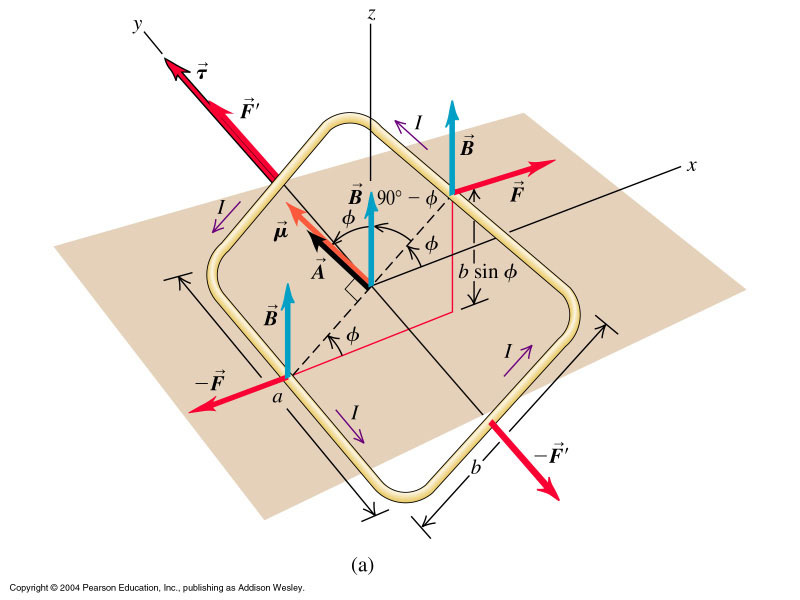Rotational Work

I have a question. I think we all agree that work done by magnetic field is ALWAYS zero, but we also have an expression for the torque acting on a current carrying rectangular loop, which would be [Torque= I(B×A)], where 'A' is the area of the rectangular loop, 'I' is the current the loop and 'B' is the magnetic field. If there's a torque there must be rotational work. From where did this rotational work come from?
No vote yet
6 votes
Easy Math Editor
This discussion board is a place to discuss our Daily Challenges and the math and science related to those challenges. Explanations are more than just a solution — they should explain the steps and thinking strategies that you used to obtain the solution. Comments should further the discussion of math and science.
When posting on Brilliant:
*italics*or_italics_**bold**or__bold__paragraph 1
paragraph 2
[example link](https://brilliant.org)> This is a quote# I indented these lines # 4 spaces, and now they show # up as a code block. print "hello world"\(...\)or\[...\]to ensure proper formatting.2 \times 32^{34}a_{i-1}\frac{2}{3}\sqrt{2}\sum_{i=1}^3\sin \theta\boxed{123}Comments
This rotation work comes from potential energy associated with the system. The loop doesn't keep rotating all the way in one direction if that what you are thinking. It either performs angular SHM(Simple Harmonic Motion) or stops at the point where potential energy is least. Think of a ball. Once its on the ground, gravity does no work on it.
Your next question might be where potential energy comes from? The answer is we provide it. There is nothing like something for nothing. Hope this help :D
Log in to reply
I disagree. It neither performs SHM nor stops at an equilibrium position. 1) It does actually performs a periodic motion 2)It shoots past the equilibrium position because of it's inertia.(http://vnatsci.ltu.edu/sschneider/physlets/main/bfieldtorque.shtml).
and besides work done by gravity may not be zero(ball example) but the work done by a magnetic field is always zero. These are two very different things. I was simply asking "What causes the motion to start?"
I give you my opinion, an non conservative electric field sets up within the conductor which only initiates the motion. Rest is done by magnetic field and inertia. Let me know what you think of it.
Log in to reply
Sorry, for the example of a ball I gave. It was in refernce to show that no motion is there once a body rests in its least potential energy.
All I meant to convey is that once you left the the loop in its least potential energy that is when it is making angle of 90 with the horizontal it doesn't move any more. Plug this value in the link you provided and verify yourself.
Thanks for pointing out that the loop doesn't perform an SHM. I was wrong about it. Only when the angle of maximum displacement is very small, only then it executes an SHM.
I don't think it would be right to say electric field in the loop initiates the motion as it doesn't initiates the motion when loop is perpendicular to the magnetic field. Rather I think it would be right to say conversion of potential energy into kinetic energy and kinety energy back to potential energy is the cause of motion.
Do you agree?
Log in to reply
Nope. this discussion is taking us nowhere. Tell me, from where do this KE or PE come from, if work done by magnetic field is always zero? Please make sure you understand what I'm asking because i am not used to type long paragraphs. For the ball example, it is totally not relevant to the topic. Let's see what we can do to make it more relevant:- why don't you drill a hole through the earth(as a chord). Now drop the the ball in this tunnel (chord). The ball performs periodic motion with min potential energy somewhere near the middle. But potential energy is coming from the GRAVITATIONAL force.
And for the electric field, I don't know. I said it might be a NON-CONSERVATIVE electric field and that too within the conductor. of course i might be wrong since this is something i have never read about. But i can't make anything else from it.
Log in to reply
Magnetic Field does rotational work in this case. (http://en.wikipedia.org/wiki/Work%28physics%29#Torqueand_rotation)
Log in to reply
You're not getting the question at all, are you? This is the first time i ever read that magnetic field does work. For the link you suggested, please read the last paragraph under the topic constraint forces. You'll realize that you are terribly misinformed.